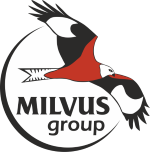
Three Natura 2000 sites (Valea Alceului, Lunca Barcăului from Bihor County and Cânepiști from Cluj County), which are in the custody of the Milvus Group, are among the first protected areas in Romania to have management plans approved by the Ministry of Environment. The main goals of these plans are related to nature conservation and the implementation of certain conservation measures.
The plans can be consulted here (in Romanian only).
The management plans were elaborated within the „Management of the ROSPA0067, ROSPA0103, ROSPA0113, ROSPA0126, ROSPA0142, ROSPA0144 and ROSCI0390 protected areas” project financed through the Environmental Operational Program – EAP Environment through the European Regional Development Fund. Our attention was focused on those Natura 2000 sites from the western part of the country which are important for the conservation of the Red-footed Falcon (
Falco vespertinus). However, besides the Red-footed Falcon, other bird species were taken into consideration as well in the elaboration process of the management plans.

The Red-footed Falcon is a migratory, endangered and protected small size raptor. The breeding ecology of this remarkable species includes, among others, a couple of special features. In the first place, these birds do not build a nest of their own, so they need to use other birds’ nests to raise their chicks. At the same time is a gregarious species and nests mainly in colonies. As the most common colonial bird in the plains (in our country) is the Rook
(Corvus frugilegus), the majority of the Red-footed Falcon population from Romania breeds in Rook colonies. A couple of years ago the Rook became a protected species during the breeding season, but in the last century, they were repelled without limits and the population of this species was reduced considerably in the distribution area of Red-footed Falcon.
The Red-footed Falcon populations have been reduced considerably for other reasons too, such as deforestations in the lowlands, transformation of the grasslands to arable fields, intensification of the agriculture and excessive use of insecticides and rodenticides. The Red-footed Falcon is also vulnerable because it is a long-distance migrant, spending the winter in southern Africa and returning to the breeding area in the middle of spring.

The management plans of the sites have been developed in the 2013-2016 period. The actions the plans were tailored upon took into consideration, among others:
- the results obtained from the inventories, mapping of the species and habitats listed in these sites and from the assessment of their conservation status,
- the results obtained from mapping the physical environment (geology, geomorphology, hydrology, climatology and soil) in the sites,
- the assessment of negative factors endangering the favourable conservation status of the bird species living in these areas,
- information about the natural protected areas obtained from different communication and awareness raising activities, such as meeting with farmers, hunting associations, teachers, representatives of the administrative, public, private and civil stakeholders.
For more details, please check the
https://milvus.ro/vespertinus page (in Romanian only)
.
 Three Natura 2000 sites (Valea Alceului, Lunca Barcăului from Bihor County and Cânepiști from Cluj County), which are in the custody of the Milvus Group, are among the first protected areas in Romania to have management plans approved by the Ministry of Environment. The main goals of these plans are related to nature conservation and the implementation of certain conservation measures. The plans can be consulted here (in Romanian only).
The management plans were elaborated within the „Management of the ROSPA0067, ROSPA0103, ROSPA0113, ROSPA0126, ROSPA0142, ROSPA0144 and ROSCI0390 protected areas” project financed through the Environmental Operational Program – EAP Environment through the European Regional Development Fund. Our attention was focused on those Natura 2000 sites from the western part of the country which are important for the conservation of the Red-footed Falcon (Falco vespertinus). However, besides the Red-footed Falcon, other bird species were taken into consideration as well in the elaboration process of the management plans.
Three Natura 2000 sites (Valea Alceului, Lunca Barcăului from Bihor County and Cânepiști from Cluj County), which are in the custody of the Milvus Group, are among the first protected areas in Romania to have management plans approved by the Ministry of Environment. The main goals of these plans are related to nature conservation and the implementation of certain conservation measures. The plans can be consulted here (in Romanian only).
The management plans were elaborated within the „Management of the ROSPA0067, ROSPA0103, ROSPA0113, ROSPA0126, ROSPA0142, ROSPA0144 and ROSCI0390 protected areas” project financed through the Environmental Operational Program – EAP Environment through the European Regional Development Fund. Our attention was focused on those Natura 2000 sites from the western part of the country which are important for the conservation of the Red-footed Falcon (Falco vespertinus). However, besides the Red-footed Falcon, other bird species were taken into consideration as well in the elaboration process of the management plans.
 The Red-footed Falcon is a migratory, endangered and protected small size raptor. The breeding ecology of this remarkable species includes, among others, a couple of special features. In the first place, these birds do not build a nest of their own, so they need to use other birds’ nests to raise their chicks. At the same time is a gregarious species and nests mainly in colonies. As the most common colonial bird in the plains (in our country) is the Rook (Corvus frugilegus), the majority of the Red-footed Falcon population from Romania breeds in Rook colonies. A couple of years ago the Rook became a protected species during the breeding season, but in the last century, they were repelled without limits and the population of this species was reduced considerably in the distribution area of Red-footed Falcon.
The Red-footed Falcon populations have been reduced considerably for other reasons too, such as deforestations in the lowlands, transformation of the grasslands to arable fields, intensification of the agriculture and excessive use of insecticides and rodenticides. The Red-footed Falcon is also vulnerable because it is a long-distance migrant, spending the winter in southern Africa and returning to the breeding area in the middle of spring.
The Red-footed Falcon is a migratory, endangered and protected small size raptor. The breeding ecology of this remarkable species includes, among others, a couple of special features. In the first place, these birds do not build a nest of their own, so they need to use other birds’ nests to raise their chicks. At the same time is a gregarious species and nests mainly in colonies. As the most common colonial bird in the plains (in our country) is the Rook (Corvus frugilegus), the majority of the Red-footed Falcon population from Romania breeds in Rook colonies. A couple of years ago the Rook became a protected species during the breeding season, but in the last century, they were repelled without limits and the population of this species was reduced considerably in the distribution area of Red-footed Falcon.
The Red-footed Falcon populations have been reduced considerably for other reasons too, such as deforestations in the lowlands, transformation of the grasslands to arable fields, intensification of the agriculture and excessive use of insecticides and rodenticides. The Red-footed Falcon is also vulnerable because it is a long-distance migrant, spending the winter in southern Africa and returning to the breeding area in the middle of spring. The management plans of the sites have been developed in the 2013-2016 period. The actions the plans were tailored upon took into consideration, among others:
The management plans of the sites have been developed in the 2013-2016 period. The actions the plans were tailored upon took into consideration, among others:
































